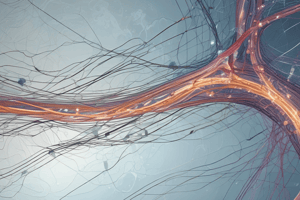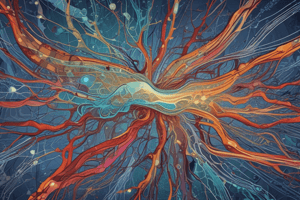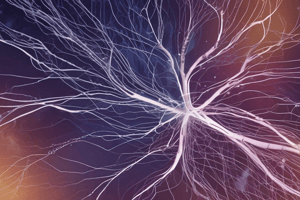Podcast
Questions and Answers
What are the universal properties of neurons?
What are the universal properties of neurons?
- Excitability, Transmission, Secretion
- Conductivity, Secretion, Reception
- Excitability, Conductivity, Secretion (correct)
- Excitability, Synthesis, Secretion
Which division of the nervous system includes the brain and spinal cord?
Which division of the nervous system includes the brain and spinal cord?
- Somatic nervous system (SNS)
- Central nervous system (CNS) (correct)
- Autonomic nervous system (ANS)
- Peripheral nervous system (PNS)
What are the two major divisions of the nervous system?
What are the two major divisions of the nervous system?
- Somatic nervous system (SNS), Autonomic nervous system (ANS)
- Central nervous system (CNS), Peripheral nervous system (PNS) (correct)
- Enteric nervous system, Sensory nervous system
- Sympathetic nervous system, Parasympathetic nervous system
What is the structure responsible for signal transmission in a neuron?
What is the structure responsible for signal transmission in a neuron?
Which cells envelop axons of the PNS and form myelin sheath?
Which cells envelop axons of the PNS and form myelin sheath?
What is the composition of myelin?
What is the composition of myelin?
What factor affects the speed at which a nerve signal travels down an axon?
What factor affects the speed at which a nerve signal travels down an axon?
Which cells provide insulation around nerve cell bodies in the ganglia of PNS?
Which cells provide insulation around nerve cell bodies in the ganglia of PNS?
What are action potentials characterized by?
What are action potentials characterized by?
What are synapses points of contact between, where neurotransmitters are released?
What are synapses points of contact between, where neurotransmitters are released?
What are EPSPs and IPSPs involved in?
What are EPSPs and IPSPs involved in?
What allows the nervous system to make decisions and process information?
What allows the nervous system to make decisions and process information?
What are the three main divisions of the brain?
What are the three main divisions of the brain?
What is the function of cerebrospinal fluid in the brain?
What is the function of cerebrospinal fluid in the brain?
Where is the medulla oblongata located?
Where is the medulla oblongata located?
What is the speed range at which neurons transmit signals?
What is the speed range at which neurons transmit signals?
What type of conduction can occur in nerve fibers?
What type of conduction can occur in nerve fibers?
What are the points of contact between neurons where neurotransmitters are released?
What are the points of contact between neurons where neurotransmitters are released?
What plays a crucial role in synaptic transmission, with different types having excitatory or inhibitory effects?
What plays a crucial role in synaptic transmission, with different types having excitatory or inhibitory effects?
What is the central nervous system composed of?
What is the central nervous system composed of?
What cells form myelin in the peripheral nervous system (PNS)?
What cells form myelin in the peripheral nervous system (PNS)?
What is the composition of myelin?
What is the composition of myelin?
Which cells provide insulation around nerve cell bodies in the ganglia of PNS?
Which cells provide insulation around nerve cell bodies in the ganglia of PNS?
What factor affects the speed at which a nerve signal travels down an axon?
What factor affects the speed at which a nerve signal travels down an axon?
Which cells form myelin in the central nervous system (CNS)?
Which cells form myelin in the central nervous system (CNS)?
What are the supportive cells in the CNS?
What are the supportive cells in the CNS?
What are the cells that envelop axons of the PNS and form myelin sheath?
What are the cells that envelop axons of the PNS and form myelin sheath?
What is the speed range at which neurons transmit signals?
What is the speed range at which neurons transmit signals?
What are the universal properties of neurons?
What are the universal properties of neurons?
What is the structure responsible for signal reception in a neuron?
What is the structure responsible for signal reception in a neuron?
What are the two major divisions of the nervous system?
What are the two major divisions of the nervous system?
What are the functional classes of neurons?
What are the functional classes of neurons?
What is the composition of myelin?
What is the composition of myelin?
What is the function of cerebrospinal fluid in the brain?
What is the function of cerebrospinal fluid in the brain?
What type of conduction involves the propagation of action potentials along unmyelinated axons?
What type of conduction involves the propagation of action potentials along unmyelinated axons?
Which part of the brain serves as a relay center for signals to the cerebellum?
Which part of the brain serves as a relay center for signals to the cerebellum?
What is the function of EPSPs and IPSPs in neural signaling?
What is the function of EPSPs and IPSPs in neural signaling?
Which part of the nervous system enables complex integration through chemical synapses?
Which part of the nervous system enables complex integration through chemical synapses?
What are the points of contact between neurons where neurotransmitters are released?
What are the points of contact between neurons where neurotransmitters are released?
What is the composition of the central nervous system's protective covering?
What is the composition of the central nervous system's protective covering?
What is the primary function of cerebrospinal fluid in the brain?
What is the primary function of cerebrospinal fluid in the brain?
Which part of the brainstem connects the hindbrain to the forebrain?
Which part of the brainstem connects the hindbrain to the forebrain?
Which structure within the midbrain is involved in pain awareness?
Which structure within the midbrain is involved in pain awareness?
Which nucleus within the midbrain relays inhibitory signals to thalamus and basal nuclei, suppressing unwanted body movement?
Which nucleus within the midbrain relays inhibitory signals to thalamus and basal nuclei, suppressing unwanted body movement?
Which part of the midbrain anchors the cerebrum to the brainstem and carries corticospinal tracts?
Which part of the midbrain anchors the cerebrum to the brainstem and carries corticospinal tracts?
Which brain region develops from the embryonic mesencephalon?
Which brain region develops from the embryonic mesencephalon?
Which part of the brainstem contains thick stalks that connect it to the cerebellum and cranial nerves 5, 6, 7, and 8?
Which part of the brainstem contains thick stalks that connect it to the cerebellum and cranial nerves 5, 6, 7, and 8?
Which part of the brainstem contains nuclei concerned with sleep, respiration, and posture?
Which part of the brainstem contains nuclei concerned with sleep, respiration, and posture?
Which part of the midbrain plays a central role in consciousness, alertness, and sleep?
Which part of the midbrain plays a central role in consciousness, alertness, and sleep?
Which part of the midbrain allows eyes to track and fixate on objects and produces rhythmic signals to the muscles of breathing and swallowing?
Which part of the midbrain allows eyes to track and fixate on objects and produces rhythmic signals to the muscles of breathing and swallowing?
Flashcards are hidden until you start studying
Study Notes
Neural Signaling and Central Nervous System Anatomy
- Neurons transmit signals at speeds ranging from 0 m/s to up to 120 m/s depending on fiber type
- Stimulation of sensory neurons can occur via chemicals, light, heat, or mechanical forces, leading to temporary changes in membrane potential
- Action potentials are all-or-none, non-decremental, and irreversible, characterized by depolarization and hyperpolarization
- Signal conduction in nerve fibers can occur through continuous or saltatory conduction
- Synapses are points of contact between neurons where neurotransmitters are released, and can be chemical or electrical
- Neurotransmitters play a crucial role in synaptic transmission, with different types of synapses having excitatory or inhibitory effects
- Postsynaptic potentials, such as EPSPs and IPSPs, are involved in summation, ultimately determining a neuron's response
- Neural integration allows the nervous system to make decisions and process information, with chemical synapses enabling complex integration
- The central nervous system includes the brain, which is divided into the forebrain, cerebellum, and brainstem
- The brain is composed of gray and white matter, and is surrounded by three protective meninges
- The brain contains ventricles filled with cerebrospinal fluid, which serves functions such as buoyancy, protection, and chemical stability
- The medulla oblongata is a brain region located at the base of the brainstem, containing various nuclei and serving as a relay center for signals to the cerebellum
Neural Signaling and Central Nervous System Anatomy
- Neurons transmit signals at speeds ranging from 0 m/s to up to 120 m/s depending on fiber type
- Stimulation of sensory neurons can occur via chemicals, light, heat, or mechanical forces, leading to temporary changes in membrane potential
- Action potentials are all-or-none, non-decremental, and irreversible, characterized by depolarization and hyperpolarization
- Signal conduction in nerve fibers can occur through continuous or saltatory conduction
- Synapses are points of contact between neurons where neurotransmitters are released, and can be chemical or electrical
- Neurotransmitters play a crucial role in synaptic transmission, with different types of synapses having excitatory or inhibitory effects
- Postsynaptic potentials, such as EPSPs and IPSPs, are involved in summation, ultimately determining a neuron's response
- Neural integration allows the nervous system to make decisions and process information, with chemical synapses enabling complex integration
- The central nervous system includes the brain, which is divided into the forebrain, cerebellum, and brainstem
- The brain is composed of gray and white matter, and is surrounded by three protective meninges
- The brain contains ventricles filled with cerebrospinal fluid, which serves functions such as buoyancy, protection, and chemical stability
- The medulla oblongata is a brain region located at the base of the brainstem, containing various nuclei and serving as a relay center for signals to the cerebellum
Studying That Suits You
Use AI to generate personalized quizzes and flashcards to suit your learning preferences.




